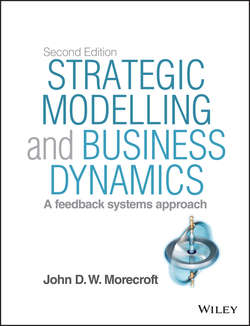Читать книгу Strategic Modelling and Business Dynamics - Morecroft John D. - Страница 19
На сайте Литреса книга снята с продажи.
CHAPTER 1
The Appeal and Power of Strategic Modelling
Model of a Natural Fishery
ОглавлениеI have taken the situation and factors outlined above and used them to create a simple fisheries model (though the scaling I use is different from Fish Banks and there are no competing fishing companies). Figure 1.5 shows the fishpopulation and regeneration. For now there are no ships or fishermen – they appear later. So what you see is a natural fishery, free from human intervention.11 The fish population or fish stock, shown as a rectangle, accumulates the inflow of new fish per year (here the inflow is defined as births minus deaths). Initially, there are 200 fish in the sea and the maximum fishery size is assumed to be 4000 fish. Incidentally, the initial value and maximum size can be re-scaled to be more realistic without changing the resulting dynamics. For example, a fishery starting with a biomass of 20 thousand tonnes of a given species and an assumed maximum fishery size of 400 thousand tonnes would generate equivalent results.
Figure 1.5 Diagram of a natural fishery
The flow of new fish per year is shown by an arrow. The size of the inflow varies according to conditions within the fishery, as explained below. This idea of a modulated flow is depicted by a tap or ‘flow regulator’ placed in the middle of the arrow. At the left end of the arrow is another special symbol, a pool or cloud, depicting the source from which the flow arises – in this case fish eggs.
A very important relationship is the effect of fish density on net regeneration, a causal link shown by a curved arrow. Since fish density itself depends on the number of fish in the fishery region, the result is a circular feedback process in which the size of the fish stock determines, through various intermediate steps, its own rate of inflow.12 The relationship is non-linear as shown in Figure 1.6.
Figure 1.6 Net regeneration as a non-linear function of fish density
When the fish density is low there are few fish in the sea relative to the maximum fishery size and net regeneration is low, at a value of less than 50 fish per year. In the extreme case where there are no fish in the sea, the net regeneration is zero. As fish density rises the net regeneration rises too, on the grounds that a bigger fish population will reproduce more successfully, provided the population is far below the presumed theoretical carrying capacity of the ocean region.
As the fish density continues to rise, there comes a point at which net regeneration reaches a peak (in this case almost 600 fish per year) and then begins to fall because food becomes scarcer. Ecologists say there is increasing intraspecific competition among the burgeoning number of fish for the limited available nutrient. So when, in this example, the fish population reaches 4000 the fish density is equal to one and net regeneration falls to zero. The population is then at its maximum natural sustainable value.
Simulated Dynamics of a Natural Fishery
If you accept the relationships described above then the destiny of a natural fishery is largely pre-determined once you populate it with a few fish. To some people this inevitability comes as a surprise, but in system dynamics it is an illustration of an important general principle: the structure of a system (how the parts connect) determines its dynamic behaviour (performance through time). A simulator shows how. The simulation in Figure 1.7 shows the dynamics of a ‘natural’ fishery over a period of 40 years, starting with a small initial population of 200 fish. Remember there are no ships and no investment. Fishermen are not yet part of the system.
Figure 1.7 Simulation of a natural fishery with an initial population of 200 fish and maximum fishery size of 4000
The result is smooth S-shaped growth. For 18 years, the fish stock (line 1) grows exponentially. The population grows from 200 to 2500 fish and regeneration (new fish per year, line 2) also increases until year 18 as rising fish density enables fish to reproduce more successfully. Thereafter, crowding becomes a significant factor according to the non-linear net regeneration curve shown in Figure 1.6. The number of new fish per year falls as the population density rises, eventually bringing population growth to a halt as the fish stock approaches its maximum sustainable value of 4000 fish.
11
The diagram was created in the popular iThink language (isee systems, 2014). The symbols are pretty much standard for all system dynamics models, though there are differences of detail between the main alternative modelling software packages. Here, in Chapter 1, I briefly explain each symbol when I first refer to it in the text. Later, in Chapter 3, there is a more formal introduction to modelling symbols and equations, with a fully documented example.
12
Interestingly, some people dispute the existence of this circularity. They argue that the number of juveniles reaching fishable size each year has nothing to do with the number of parents in the sea because fish such as cod can produce upwards of seven million eggs in a season – most of which perish due to predation and environmental factors. However, the number of fish eggs is certainly related to the population of fish.
